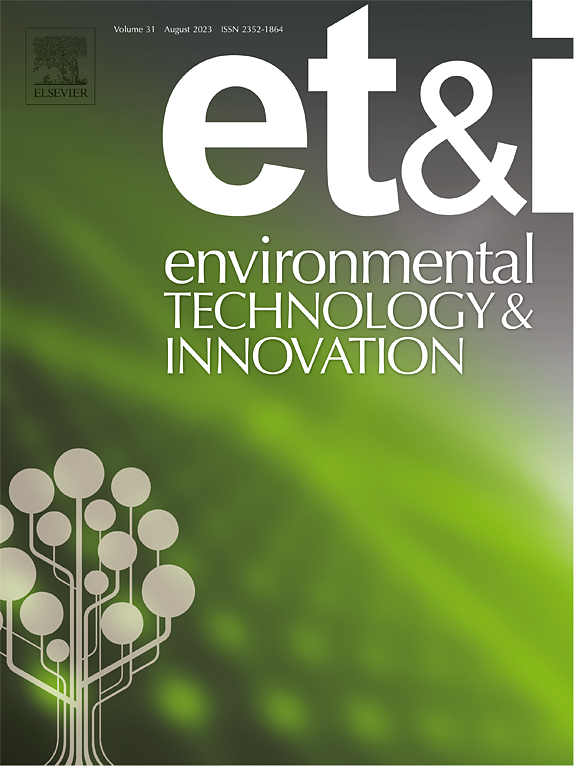磁性纳米颗粒刺激番茄生长和诱导抗番茄枯萎病的研究进展
IF 7.1
2区 环境科学与生态学
Q1 BIOTECHNOLOGY & APPLIED MICROBIOLOGY
引用次数: 0
摘要
农业生产力面临来自真菌病和营养缺乏的日益严峻的挑战,需要创新的解决办法。虽然氧化铁纳米颗粒在农业中显示出前景,但它们对激素介导的生长调节和抗病的影响仍然知之甚少。研究了Fe₃O₄NPs对番茄生长和抗番茄枯萎病的影响。番茄幼苗用水培法生长,并用0.5和1.0 mg/L Fe₃O₄NPs或等效的FeCl₃浓度处理。与对照相比,0.5 mg/L Fe₃O₄NPs处理使根长度增加了100 %,茎长增加了40 %,优于FeCl₃处理,后者分别使根和茎长增加了36.7 %和8.5 %。Fe₃O₄NPs下调aba相关基因,在24 小时后,FMO、MYB71和DnaJ1的表达分别下降了71 %、46 %和55 %。接种前用0.5 mg/L Fe₃O₄NPs处理的幼苗显示,疾病严重程度降低了62.9 % (AUDPC值为1.3,而对照组为3.7),感染后48 小时ROS积累增加了5倍。Fe₃O₄NPs强烈诱导了防御相关基因,在12 小时内,PR1a、LoxC和AOC的表达分别增加了14倍,182.1 %和111.2 %。在处理后12和24小时,SA水平分别升高56.1% %和68.6% %。当np处理的植物受到Fol的刺激时,这种启动效应被放大。这些发现证明了Fe₃O₄NPs作为多功能纳米肥料的潜力,通过调节植物激素途径促进生长和抗病性。本文章由计算机程序翻译,如有差异,请以英文原文为准。
Insights into tomato growth stimulation and induced resistance against Fusarium oxysporum f. sp. lycopersici by magnetite nanoparticles
Agricultural productivity faces increasing challenges from fungal diseases and nutrient deficiencies, necessitating innovative solutions. While iron oxide nanoparticles show promise in agriculture, their effects on hormone-mediated growth regulation and disease resistance remain poorly understood. This study investigated the effects of Fe₃O₄ NPs on tomato growth and resistance against Fusarium oxysporum f. sp. lycopersici Fol. Tomato seedlings were hydroponically grown and treated with 0.5 and 1.0 mg/L Fe₃O₄ NPs or equivalent FeCl₃ concentrations. Treatment with 0.5 mg/L Fe₃O₄ NPs enhanced root length by 100 % and shoot length by 40 % compared to controls, outperforming FeCl₃ treatments which increased root and shoot length by only 36.7 % and 8.5 %, respectively. Fe₃O₄ NPs downregulated ABA-related genes, with FMO, MYB71, and DnaJ1 expression decreasing by 71 %, 46 %, and 55 % respectively after 24 hours. Seedlings treated with 0.5 mg/L Fe₃O₄ NPs before Fol inoculation showed a 62.9 % reduction in disease severity as measured by AUDPC value of 1.3 versus 3.7 in controls and a 5-fold increase in ROS accumulation at 48 hours post-infection. Fe₃O₄ NPs strongly induced defense-related genes, with PR1a, LoxC, and AOC showing 14-fold, 182.1 %, and 111.2 % increased expression respectively within 12 hours of treatment. SA levels increased by 56.1 % and 68.6 % at 12- and 24-hours post-treatment. This priming effect was amplified when NP-treated plants were challenged with Fol. These findings demonstrate Fe₃O₄ NPs’ potential as a multifunctional nano-fertilizer, promoting both growth and disease resistance through modulation of phytohormone pathways.
求助全文
通过发布文献求助,成功后即可免费获取论文全文。
去求助
来源期刊

Environmental Technology & Innovation
Environmental Science-General Environmental Science
CiteScore
14.00
自引率
4.20%
发文量
435
审稿时长
74 days
期刊介绍:
Environmental Technology & Innovation adopts a challenge-oriented approach to solutions by integrating natural sciences to promote a sustainable future. The journal aims to foster the creation and development of innovative products, technologies, and ideas that enhance the environment, with impacts across soil, air, water, and food in rural and urban areas.
As a platform for disseminating scientific evidence for environmental protection and sustainable development, the journal emphasizes fundamental science, methodologies, tools, techniques, and policy considerations. It emphasizes the importance of science and technology in environmental benefits, including smarter, cleaner technologies for environmental protection, more efficient resource processing methods, and the evidence supporting their effectiveness.
 求助内容:
求助内容: 应助结果提醒方式:
应助结果提醒方式:


